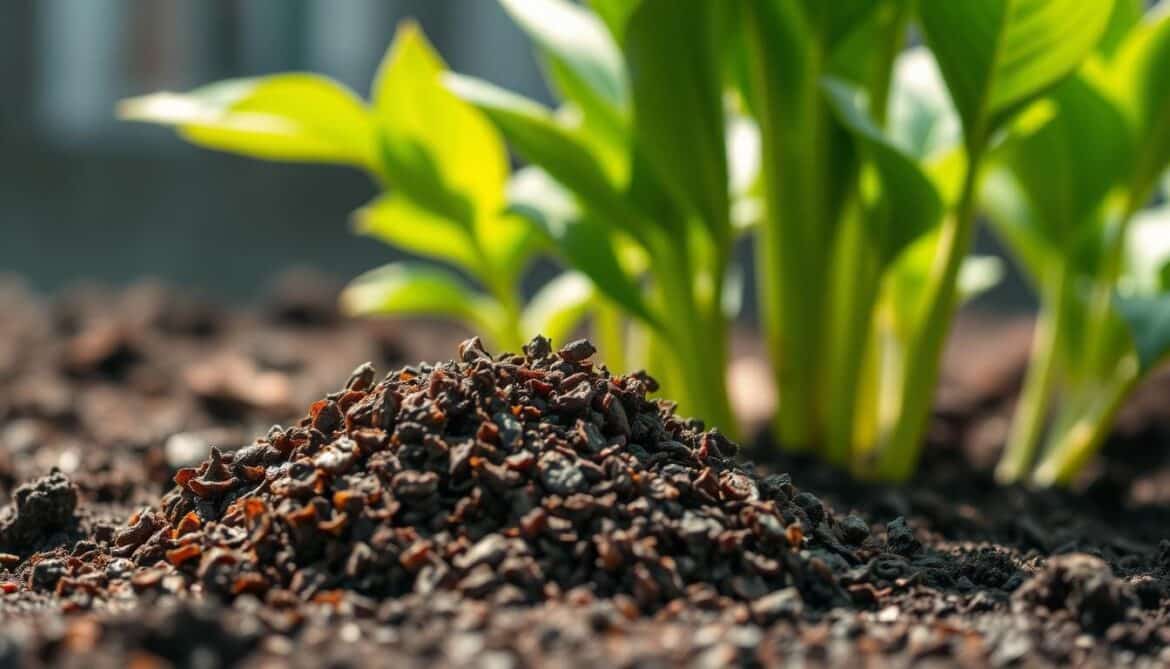Imagine a garden where plants grow strong without harmful chemicals. The soil feels alive, and every plant that blooms or fruit that ripens is a victory. For many gardeners, this dream comes true with organic fertilizer made from worm castings. These tiny nutrient powerhouses are more than compost; they connect ancient soil wisdom with modern gardening success.
Whether you have a backyard garden or a balcony herb garden, worm castings can help. They are a sustainable way to improve soil health and make plants stronger.
Worm castings are nature’s perfect gift. They are full of nutrients like calcium and nitrogen, ready to feed roots without harming them. Unlike harsh chemicals, they work softly, making ordinary soil fertile for plants to grow.
For those who want to avoid chemicals, worm castings are a reliable, eco-friendly choice. They strengthen soil and support long-term health. This is more than gardening; it’s a partnership with nature.
Key Takeaways
- Worm castings act as a natural, nutrient-rich organic fertilizer for plants.
- They improve soil health by making it better structured and water-retentive.
- Using worm castings aligns with sustainable gardening practices.
- They’re safe for all plants, from houseplants to large-scale crops.
- They offer a chemical-free alternative to synthetic fertilizers.
What are Worm Castings?
Worm castings, or vermicompost, are organic material changed by earthworm digestion. This
Definition of Worm Castings
Worm castings are what’s left after worms digest organic matter. They are different from regular compost because they have good microbes and enzymes. These help the soil breathe better and hold water.
Scientists say worm castings have a better mix of nutrients than regular fertilizers.
How Worm Castings Are Produced
Production has three main steps:
- Earthworms eat decaying plant stuff like leaves or food scraps.
- Microbes in their gut turn this into simpler nutrients.
- Then, the castings come out as pH-balanced pellets full of humic acids.
| Aspect | Worm Castings | Regular Compost |
|---|---|---|
| Nutrient Content | Higher microbial activity | Less microbial diversity |
| Production Time | 6-8 weeks | 3-6 months |
| pH Level | Neutral (6.0-7.0) | Varies widely |
These nutrient-rich compost bits give out nutrients slowly. This means less waste and better soil for plants. Their special structure also stops soil from getting too hard, making it perfect for roots.
Benefits of Using Worm Castings
Worm castings turn regular garden soil into a lively ecosystem. They are a natural way to improve soil, helping plants grow better. This makes the soil great for both roots and leaves.
Nutrient-Rich Composition
Worm castings have the nutrients plants need. They have:
- Essential macronutrients: nitrogen for leaf growth, phosphorus for root development, and potassium to fight stress
- Trace elements like calcium, magnesium, and zinc that act as growth accelerants
These nutrients stay in a form that plants can use for months. They don’t wash away easily.
Improved Soil Structure
Castings change soil at a tiny level. They make the soil more open and porous. This is thanks to their sticky organic matter.
“Soil structure improvements from worm castings are unmatched by few amendments,” says soil scientist Dr. Emily Green. “They create the perfect balance of air and moisture pathways.”
Enhanced Water Retention
Castings hold a lot of water. They can hold up to 10x their weight in water. This helps prevent water from staying too long in the soil.
– Reduces irrigation needs by 30-50% in many soils
– Stops root rot by aerating waterlogged soil
These benefits work together. Plants get the nutrients they need, roots get oxygen, and water is evenly spread. This is key for healthy soil over time.
How to Use Worm Castings in Your Garden
Make your garden better with worm castings, a great organic fertilizer. They make your soil better naturally. These worm castings are good for many plants. Here’s how to use them best.
Application Methods
There are easy ways to add worm castings:
- Top Dressing: Put a thin layer around plants, but not on stems. It adds nutrients without harming roots.
- Soil Mix: Mix 20% castings with soil for better structure and to hold water.
- Seed Starting: Use 50% castings in your mix for strong seedlings.
- Compost Tea: Soak castings in water for 24 hours. Then, use the liquid on plants or in soil.
Best Practices for Different Plants
Use them differently for different plants:
- Vegetables: Add 1 cup per plant when planting. For garlic, use harvesting tips for bigger bulbs.
- Flowering Plants: Mix 1 part castings with 3 parts soil in pots for more blooms.
- Shrubs & Trees: Put a 2-inch layer around the base each year for better roots.
- Indoor Plants: Top-dress every 3 months to keep nutrients up.
Worm castings fit any garden, giving lasting benefits safely.
Comparing Worm Castings to Other Fertilizers
Worm castings are special because they help plants grow in a healthy way. They don’t harm plants like some other fertilizers do. This is because they are made from natural stuff.
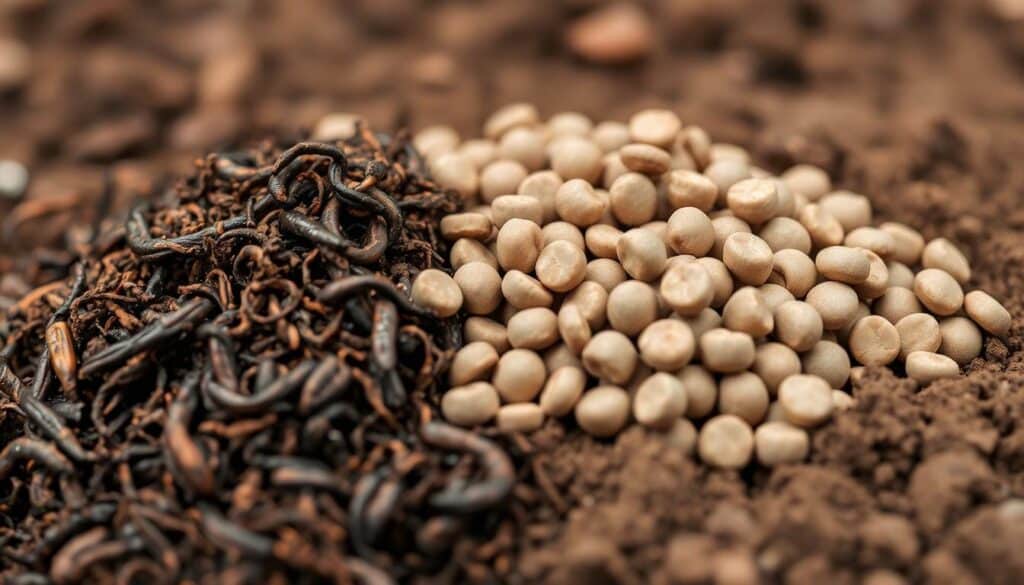
Nutrient Release Rate
Worm castings give nutrients slowly, so plants can use them all the time. Other fertilizers can give too much too fast, hurting plants. The nutrient-rich compost in worm castings makes nutrients like nitrogen and potassium ready for plants right away.
This is different from chemical fertilizers that give a lot of nutrients at once. Then, the soil is left empty of nutrients.
Environmental Impact
Other organic fertilizers can have bad stuff in them. But worm castings are good for the soil and don’t harm it. They have many benefits:
- They help reduce waste by turning it into compost.
- They prevent pollution by not letting nutrients run off.
- They help keep carbon in the soil.
“Worm castings outperform conventional fertilizers in maintaining soil biodiversity over time.” – Soil Science Research Institute
Research shows worm castings make soil better forever. But other fertilizers can hurt the soil over time. This makes worm castings a great choice for those who care about the environment.
DIY: How to Create Your Own Worm Castings
Start by turning kitchen scraps into worm castings with a simple setup. This guide will show you how to make vermicompost at home. It’s great for gardeners looking for an affordable organic fertilizer. First, gather these basics:
Materials Needed
- Plastic or wooden bin with drainage holes
- Bedding material (shredded newspaper or coconut coir)
- Red wiggler worms (Eisenia fetida)
- Food scraps (fruit/vegetable peels, coffee grounds)
- Moisture meter (optional)
Step-by-Step Process
- Line bin with bedding, moistening it to a sponge-like texture.
- Add worms, burying food scraps 2–3 inches deep.
- Keep the temperature between 55–77°F (13–25°C) and maintain damp conditions.
- Harvest castings after 2–3 months by separating worms from the finished vermicompost.
| Problem | Solution |
|---|---|
| Foul odor | Add dry bedding to absorb excess moisture |
| Worms escaping | Cover bin and ensure consistent feeding schedule |
Turn food waste into organic fertilizer in just 90 days. This system works in any space, from apartments to backyards. It gives you a steady supply of nutrient-rich worm castings for your plants.
The Role of Worm Castings in Organic Gardening
Organic gardening focuses on natural ways to create healthy ecosystems. Worm castings are key in achieving this, meeting standards and improving food quality.

Organic Certification Standards
Growers often use worm castings to follow USDA Organic and OMRI Listed® rules. These rules ban synthetic additives, making worm castings a top organic fertilizer.
| Certification | Requirements | Worm Castings Compliance |
|---|---|---|
| USDA Organic | No synthetic chemicals | 100% natural production |
| OMRI Listed® | Prohibited substance-free | Meets all criteria |
Health Benefits of Organic Produce
Studies suggest plants grown with worm castings may have more nutrients. A 2023 study in Journal of Sustainable Agriculture found these plants had 20% more antioxidants.
- Rich in microbial life that boosts soil health
- Encourages plant uptake of vitamins and minerals
Using these amendments helps gardeners avoid chemical additives. This supports organic gardening’s goals of nourishing soil and people.
Common Misconceptions About Worm Castings
Many gardeners are unsure about worm castings because of myths. Let’s clear up these misconceptions to help you make better choices.
Worm Castings vs. Regular Compost
Not all organic matter is created equal. Here’s how worm castings stand out from regular compost:
| Comparison Area | Worm Castings | Regular Compost |
|---|---|---|
| Nutrient-Rich Compost Levels | 3x higher nutrients | Lower nutrient density |
| Microbial Activity | Abundant beneficial microbes | Less microbial diversity |
| pH Balance | Near-neutral pH (6.0-7.0) | Varies widely depending on materials |
Myths Surrounding Using Worms
- Myth 1: “Worms escape bins easily.” Fact: Red wigglers (Eisenia fetida) thrive in controlled conditions and rarely leave properly maintained bins.
- Myth 2: “Vermicompost smells bad.” Fact: Properly managed systems stay odor-free, unlike rotting compost piles.
- Myth 3: “Worm bins need constant attention.” Fact: Once established, they require weekly feeding and monthly maintenance.
- Myth 4: “Only works in warm climates.” Fact: Indoor systems function year-round regardless of outdoor temperatures.
By debunking these myths, gardeners can see the real value of vermicompost. It offers unmatched benefits without the common misconceptions.
Choosing the Right Worms for Casting Production
Choosing the right earthworm species is essential for high worm castings yields. The correct worms produce top-notch vermicompost, a powerful soil enhancer. Here’s how to pick and source them effectively.
Best Worm Species for Castings
Three species are leaders in worm composting systems:
| Species | Production Rate | Temp Tolerance | Cost/1000 Worms |
|---|---|---|---|
| Red Wigglers (Eisenia fetida) | Fastest | 50–85°F | $20–$30 |
| European Nightcrawlers (Eisenia hortensis) | Moderate | 40–75°F | $30–$40 |
| African Nightcrawlers (Eudrilus eugeniae) | High volume | 65–85°F | $25–$35 |
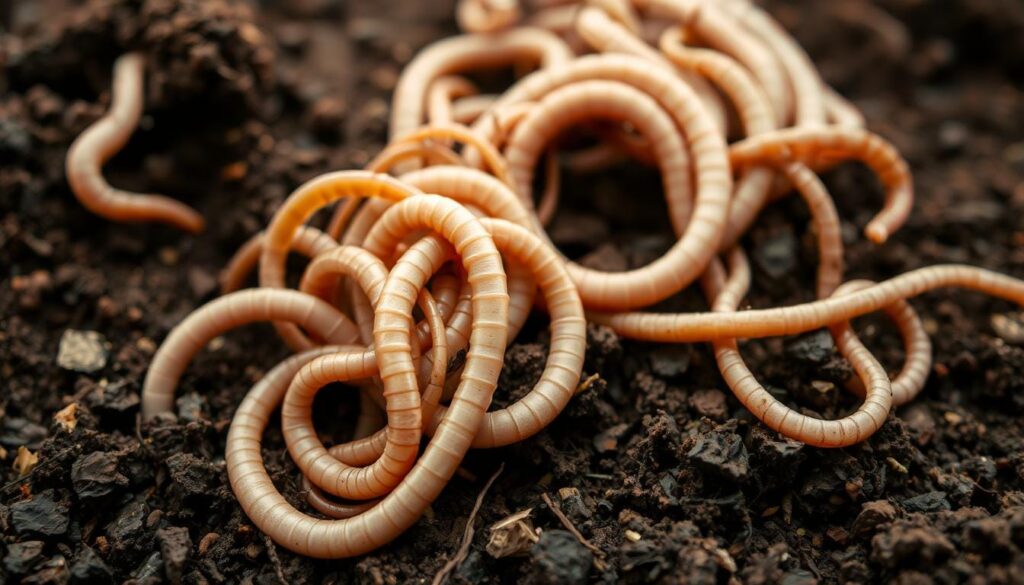
Where to Purchase Quality Worms
Seek out suppliers with certified earthworms. Steer clear of slow or mucus-covered worms—they’re unhealthy. Here are some tips:
- Look for USDA Organic certifications
- Make sure shipping methods are safe
- Prices start at $20 per 1000
“Healthy worms are the backbone of productive vermicompost systems.” – USDA Agricultural Research Service
Start with 1–2 pounds of worms for small setups. Check their activity weekly for the best soil enhancer output. Focus on their specific needs to improve worm castings quality and yield.
Incorporating Worm Castings into Hydroponics
Hydroponic growers can now use worm castings to improve plant health in soilless systems. These worm castings add organic benefits to modern setups. They blend nature with cutting-edge technology.
Benefits for Hydroponic Systems
- Microbial diversity in castings boosts root health without soil.
- Natural nutrient-rich compost slowly releases minerals, cutting down on synthetic additives.
- Castings help fight diseases by supporting balanced microbial activity.
Considerations and Tips
When adding castings to NFT, DWC, or ebb-and-flow systems:
- Strain castings through mesh to prevent clogs in pumps or drippers.
- Make compost tea by soaking castings in water for nutrient solutions.
- Keep an eye on EC levels to balance worm castings with hydroponic nutrients.
Regular testing helps keep soil health metrics in water-based systems. Begin with small trials to adjust to your setup’s needs.
Worm Castings for Indoor Plant Care
Indoor plants love worm castings, a natural fertilizer that keeps them healthy. These pellets make soil better in small pots, helping roots breathe and drink. They’re perfect for homes or apartments, as they prevent soil from getting too dense and don’t smell bad like some other products.
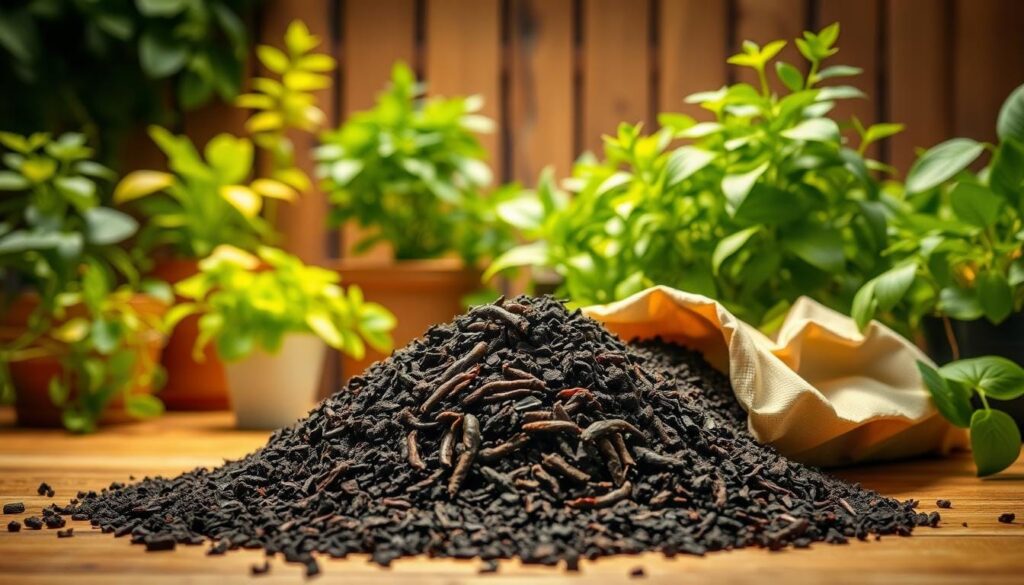
Effective Use in Houseplants
For new plants, mix 1-2 inches of worm castings into the soil. For plants you already have, add a quarter-inch layer on top. This natural soil booster fights pests like fungus gnats by keeping the soil’s pH balanced. But don’t overdo it—use only 10% castings to avoid harming the roots.
Performance in Container Gardening
Container plants get a steady supply of nutrients from worm castings. Here’s a guide for how much to use:
| Plant Type | Castings Ratio | Frequency |
|---|---|---|
| Herbs | 20% mix | Every 3 months |
| Ferns | 15% mix | Every 6 months |
| Cacti | 10% mix | Once yearly |
“Worm castings make indoor gardening easier. My houseplants have greener leaves and fewer pests after switching to this organic fertilizer.” – Indoor Gardener’s Journal
Worm castings are great for hanging baskets or balcony containers, keeping them moist. Mix them with peat moss for better drainage. They’re safe for pets and kids because they’re free from harmful pathogens. For the best results, refresh the soil every year with new worm castings to keep the nutrients flowing.
Measuring the Effectiveness of Worm Castings
Start by watching how soil health and plant growth change. These steps show if your garden soil enhancer is doing its job.
Signs of Healthy Soil
- Soil feels crumbly, not clumpy or hard
- More earthworms show up in treated spots
- Water drains quicker during watering tests
- Less crust forms on the soil after rain
The worm castings infiltration test shows soil getting better over months. Just pour water and see how fast it soaks in.
Plant Growth Metrics
| Metric | Measurement Method |
|---|---|
| Germination success | Compare seedling emergence rates between treated and untreated soil |
| Leaf development | Track leaf count and color intensity using a greenness chart |
| Stem strength | Measure stem diameter at soil level |
| Flowering duration | Record bloom start/end dates and flower count |
It may take 6-18 months to see the full benefits. But using worm castings regularly will improve soil and plant health over time.
Storing and Preserving Worm Castings
Storing worm castings right keeps them effective as organic fertilizer. They are full of living microbes that make soil healthier. The right methods keep them working well for months.
“Moisture and temperature control are key to preserving microbial life in worm castings,” advises the Organic Materials Review Institute (OMRI).
Optimal Storage Conditions
Here’s how to keep them in top shape:
- Moisture Levels: Keep castings dry, ideally below 30% moisture to stop mold.
- Temperature: Store them between 50–70°F (10–21°C). High or low temps harm the good bacteria.
- Containers: Use airtight, opaque bins to keep out light and air.
- Location: Pick a cool, dry spot like a basement or pantry. Avoid garages or attics.
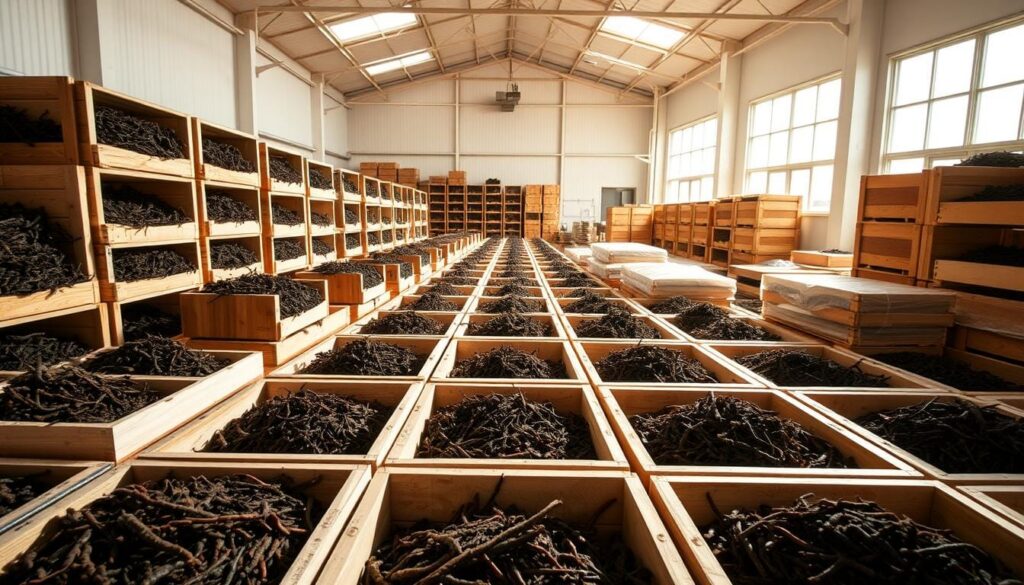
Shelf Life of Castings
When stored right, worm castings last 6–12 months. Several things affect how long they last:
- Moisture Exposure: Too much humidity makes them spoil faster.
- Temperature Fluctuations: Heat for too long kills the microbes.
- Container Integrity: Containers that leak or are porous let in bad stuff.
Look out for signs of spoilage like bad smells or mold. If you see these, throw out the castings and get new ones. Stored properly, they keep their nutrient-rich compost benefits longer than synthetic stuff.
Worm Castings and Pest Management
Worm castings do more than just feed plants—they also keep pests away. They improve soil health, making it hard for pests to live.
Natural Pest Deterrent Properties
Worm castings have chitinase, an enzyme that harms pests like aphids and nematodes. The castings also fight off soil diseases. A study by OrganicControl found that castings can cut disease by 40%.
Using Castings as a Soil Amendment
To fight pests, mix castings into soil at a 20% ratio. Here’s how to use them:
- Layer 1-2 inches around plant bases
- Combine with compost for raised beds
- Use as a top dressing for potted plants
Use castings with other organic methods like planting friends together. For pepper plants, mix this with watching for diseases, as ChikusGarden’s guide suggests. Apply every 6-8 weeks to keep pests away without chemicals.
Future Trends in Worm Casting Usage
Worm castings and vermicompost are changing farming and gardening. They are key to improving soil health. New uses are emerging, helping meet global sustainability goals.
Innovations in Sustainable Agriculture
Big farms are using worm castings with biochar to make soil better. They create special vermicompost for different crops. New tech helps farms work more efficiently and fight climate change.
Increasing Popularity Among Home Gardeners
More people are using vermicompost for green gardening. They use easy-to-use products like granules and liquid extracts. Online resources and local workshops help them learn.
Groups focused on composting are also growing. They make worm castings a common gardening tool.
